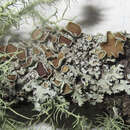Comprehensive Description
provided by Smithsonian Contributions to Botany
Hypotrachyna pulvinata
Parmelia pulvinata Fee, 1824:123. [Type collection: Tropical America (G, lectotype).]
Parmelia subsinuosa Nylander, 1885:613. [Type collection: Tropical America, Bonpland (H, Nylander herbarium number 35169, lectotype; P, isolectotype).]
P. caraccensis f. pulvinata (Fée) Zahlbruckner, 1929:58.
Thallus adnate to loosely attached, whitish mineral gray, 8–12 cm broad; lobes short and often crowded, sublinear, 2–6 mm wide; upper surface plane, shiny, white-maculate; lower surface densely rhizinate, the rhizines often projecting as a mat beyond the margins, densely dichotomously branched. Apothecia common, adnate, 5–17 mm in diameter, the amphithecium strongly white-maculate; spores 6μ–7μ × 10μ–13μ.
CHEMISTRY.—Cortex K+ yellow, medulla K−, C+ red, KC+ red, P− (atranorin, evernic acid, and lecanoric acid.
DISTRIBUTION.—Southwestern United States, Mexico, Central America, Jamaica, Andean region from Venezuela to Bolivia, and southeastern Brazil.
HABITAT.—On trees (oak, pine), soil, over mosses in pine forests, scrubby mist forest, and paramo at 1200–4300 m elevation.
- bibliographic citation
- Hale, Mason E., Jr. 1975. "A Revision of the Lichen Genus Hypotrachyna (Parmeliaceae) in Tropical America." Smithsonian Contributions to Botany. 1-73. https://doi.org/10.5479/si.0081024X.25

